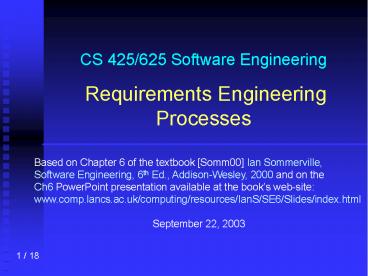CS 425/625 Software Engineering Requirements Engineering Processes - PowerPoint PPT Presentation
Title:
CS 425/625 Software Engineering Requirements Engineering Processes
Description:
Consistency checks. Completeness checks. Reality/feasibility checks. Verifiability ... Automated consistency analysis. 13 / 18 ..Requirements Validation ... – PowerPoint PPT presentation
Number of Views:98
Avg rating:3.0/5.0
Title: CS 425/625 Software Engineering Requirements Engineering Processes
1
CS 425/625 Software Engineering Requirements
Engineering Processes
- Based on Chapter 6 of the textbook Somm00 Ian
Sommerville, - Software Engineering, 6th Ed., Addison-Wesley,
2000 and on the - Ch6 PowerPoint presentation available at the
books web-site - www.comp.lancs.ac.uk/computing/resources/IanS/SE6/
Slides/index.html - September 22, 2003
2
Outline
- Introduction
- Feasibility Studies
- Requirements Elicitation and Analysis
- Requirements Validation
- Requirements Management
3
Introduction
- The requirements engineering process Fig. 6.1,
Somm00
4
Feasibility Studies
- The input of a feasibility study is an outline
description of the system - The output is a report which recommends or not
continuing the development process - Activities
- Information collection
- Information assessment
- Report writing
- Questions asked during feasibility studies
- What contribution brings the new system to the
organization? - Can the system be built given its specific
constraints? - Can the system be integrated with already
existing systems in the organization?
5
Requirements Elicitation Analysis
- Involves work with costumers and end-users to
define the services and constraints of the system - Stakeholders people who have direct or indirect
influence on the way the systems requirements
are shaped - Challenges of requirements elicitation and
analysis - Stakeholders not clear about what they want
- Domain knowledge implicitly assumed
- Various ways of expressing requirements
- Political considerations involved
- Dynamic business and economic environment
6
.Requirements Elicitation Analysis.
- The requirements elicitation analysis process
- Fig. 6.2, Somm00
7
..Requirements Elicitation Analysis
- Three techniques for requirements elicitation and
analysis - Viewpoint-oriented elicitation various
stakeholders points of view are taken into
consideration (section 6.2.1 in Somm00) - Scenario-based elicitation and analysis using
concrete sections of operations the details of
the systems requirements emerge - Ethnography technique that focuses on
understanding social and organizational
requirements (section 6. 2.3 in Somm00)
8
Requirements Elicitation Analysis..
- Event scenarios Fig. 6.10, SE-6
9
.Requirements Elicitation Analysis.
- Use-cases Fig. 6.12, Somm00
10
..Requirements Elicitation Analysis
- Sequence diagram Fig. 6.13, Somm00
11
Requirements Validation..
- Requirements validation has the goal of ensuring
that the system requirements do represent in fact
what the user wants - It is a form of requirements analysis which works
with a complete set of requirements - Very important activity since discovering
problems with requirements at this stage saves a
significant amount of money
12
.Requirements Validation.
- Types of checks for requirements validation
- Validity checks
- Consistency checks
- Completeness checks
- Reality/feasibility checks
- Verifiability
- Techniques for requirements validation
- Reviews
- Prototyping
- Test-case generation
- Automated consistency analysis
13
..Requirements Validation
- Automated consistency analysis of requirements
Fig. 6.15, Somm00
14
Requirements Management.
- Requirements management is necessary because new
requirements tend to emerge continuously. Its
goal is to understand and control new
requirements - Reasons for new requirements
- Large systems have many users, with distinct sets
of requirements, preferences, and priorities - Differences between the views of customers (who
pay for the system) and end-users (who actually
work with the system) - The systems environment evolves continuously
15
.Requirements Management
- Requirements from an evolution standpoint
- Enduring requirements
- Volatile requirements
- Mutable
- Emergent
- Consequential
- Compatibility requirements
- Requirements management planning involves
decisions on - Identification of new requirements
- Change management process
- Traceability of requirements
- Tool support
16
..Requirements Management..
- Requirements Evolution Fig. 6.16, Somm00
17
Requirements Management.
- Traceability Matrix Fig. 6.18, Somm00
18
.Requirements Management
- Change management Fig. 6.19, SE-6































